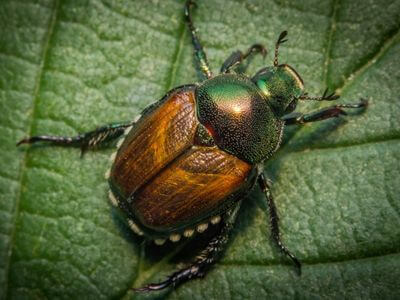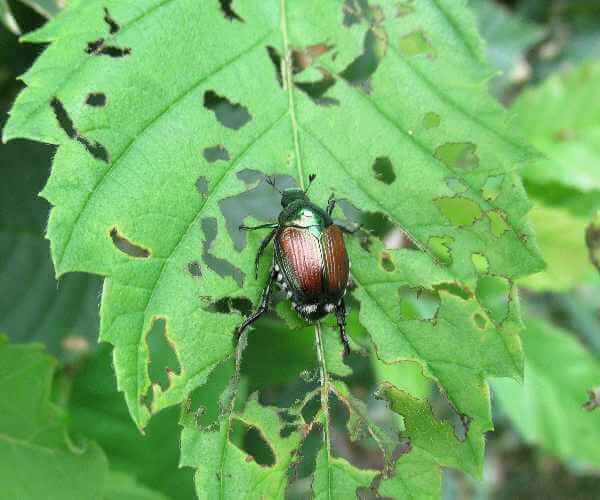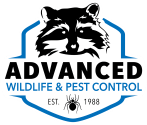Japanese Beetle Removal Services in Wisconsin
For expert Japanese beetle removal services in Wisconsin, you need Advanced Wildlife & Pest Control. We have the tools and expertise to rid your garden of these invasive critters, which can be a gardener’s worst nightmare. They feast on plants, flowers, and crops, leaving tattered foliage and devastated gardens behind. Unfortunately, their destructive power is often evident in Milwaukee and Waukesha Counties and beyond. This guide will inform you about Japanese beetles, their life cycle, and the most effective methods of Japanese beetle control.

What Are Japanese Beetles?
Japanese beetles are invasive pests originally from Japan that were discovered in the U.S. more than a century ago. They’re known for their voracious appetites and destructive impact on over 300 types of plants. They pose a particular threat to gardens, ornamental plants, and crops such as soybeans, corn, and grapes. Due to their lack of natural predators in the U.S., Japanese beetles have become a major problem for gardeners and farmers. However, we can keep their population in check and reduce their damage with proper pest control practices.
What Do Japanese Beetles Look Like?
Japanese beetles are easy to identify because of their metallic green bodies and copper-colored wing covers. Adult beetles are typically about a half-inch long and have small white tufts of hair along their sides. Their shiny, jewel-like appearance makes them stand out. But don’t be fooled by their beauty. They can wreak havoc on your garden in no time.
Meanwhile, their immature form – known as grubs – are white, C-shaped larvae that live in the soil. Grubs frequently lurk in lawns and can significantly damage grass roots. Spotting such issues early can help you take swift action.

Identifying Japanese Beetle Damage
Adult Japanese beetles feed on leaves, flowers, and the fruits of plants. When they’re done eating, all that’s left are skeletonized leaves with only their veins intact. This type of damage is easy to spot. Grubs, on the other hand, eat grass roots, leading to brown, dead patches in your lawn. Early detection is key to effective Japanese beetle control, so be sure to regularly scout for these pests. Here’s how:
- Inspect Plants Regularly – Pay close attention to roses, fruit trees, grapes, and other Japanese beetle favorites.
- Check for Skeletonized Leaves – Look for leaves that appear to have been chewed, with only the veins remaining.
- Monitor Your Lawn – Brown patches in your grass could signify grub activity beneath the surface. Dig up a small patch of turf to look for C-shaped larvae.
Understanding the Life Cycle of a Japanese Beetle
Understanding the Japanese beetle life cycle will help you determine the best time for treatment. Japanese beetles go through four stages of life. By targeting them during the grub stage in the fall or the pupae stage in early spring, you can dramatically reduce their population before they become adults. Here are their phases:
- Eggs – Laid in soil during mid-to-late summer
- Grubs – Hatch from eggs and feast on grass roots during late summer and fall
- Pupae – Overwinter in the soil and transform
- Adults – Emerge in summer – typically June or early July – to begin feeding and mating
When to Seek Japanese Beetle Control
If you notice significant beetle or grub activity, it’s time to invest in professional Japanese beetle removal from our pest control company. Advanced Wildlife & Pest Control’s comprehensive services provide targeted solutions and long-lasting results, saving our customers time and frustration. Signs that treatment is necessary include:
- Heavy feeding damage to your plants and trees
- Persistent infestation despite DIY efforts
- Extensive lawn damage caused by grubs
Japanese Beetle Response and Management Approaches
There are several effective Japanese beetle control methods to consider, both on your own and with the help of a professional. Among them are:
- Cultural Practices – You can manually remove beetles by shaking them off plants into a bucket of soapy water early in the morning. You may also keep your lawn healthy with proper fertilization and irrigation to minimize grub damage.
- Biological Control – Introduce natural predators like nematodes or milky spore bacteria to target Japanese beetle grubs in the soil. This approach is organic and eco-friendly.
- Chemical Treatments – For heavy infestations, you may need to use insecticides to kill Japanese beetles and grubs. Our licensed experts can safely introduce Japanese beetle killers around your property for fast results.
- Professional Services – We promise a thorough and strategic approach to Japanese beetle removal. Our experts specialize in identifying and treating Japanese beetle problems throughout Wisconsin.
Contact Us for Japanese Beetle Control Today
When Japanese beetles invade, quick action is essential to minimize damage. Advanced Wildlife & Pest Control has been helping customers in Milwaukee, Waukesha, Ozaukee, and Washington Counties and beyond for more than three decades. From assessing an infestation’s extent to implementing safe and effective treatments to get rid of Japanese beetles, we have you covered. So, don’t wait until Japanese beetles destroy your lawn or garden. Contact us today to schedule a consultation.
Frequently Asked Questions
Are Japanese beetles an invasive species in Wisconsin?
Japanese beetles are an invasive species in Wisconsin. The beetle is native to Japan and was first noticed in the eastern United States in the early 1900s through international commerce and trade. Japanese beetles survived because of the favorable climate, various species of plants to feed on, and few natural predators.
What do Japanese beetles eat?
Japanese beetles feed on many different plants. Adults eat the leaves, flowers, and fruits. Preferred plants include rose, linden, grape, apple, crabapple, cherry, maple, and plum trees. They will also eat corn, okra, rhubarb, raspberries, and asparagus. Japanese beetle larvae or grubs feed on grass roots in the soil.
Do Japanese beetles bite?
Japanese beetles do not bite or sting. Their mandibles are used to chew leaves and are too weak to break through skin. They do have spiny legs that might feel prickly against your skin.
Do NOT use beetle traps!
Japanese beetle bag traps actually attract more beetles to your yard. You’ll be attracting beetles from all over town and end up with a worse problem!
